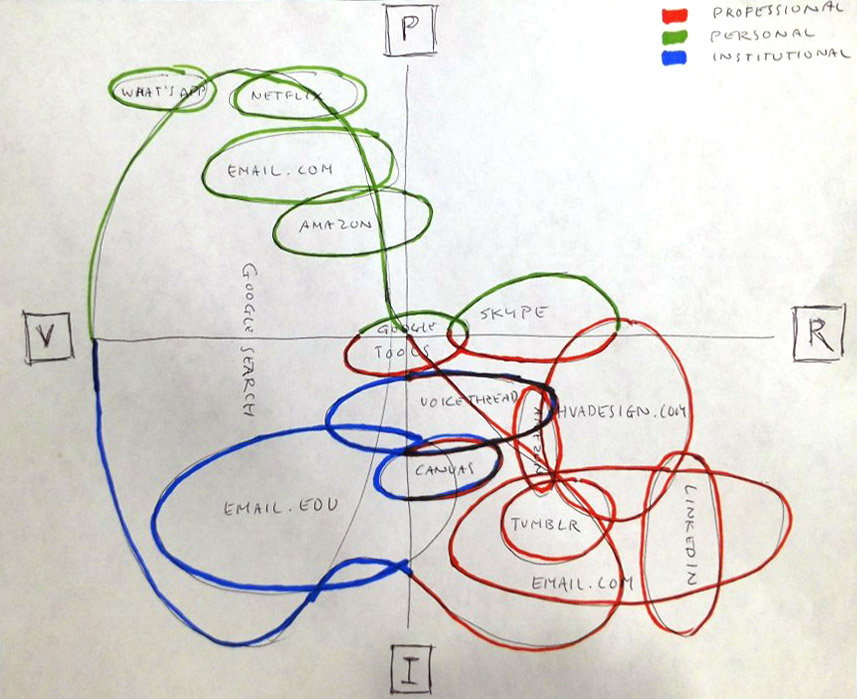Last week I helped to run two Visitors and Residents mapping workshops in the United States. The first one at The New School in New York was in the ‘opportunity to reflect’ mode which we have run with staff and students before. The second one was a new, two day, format designed to inform the direction of Carnegie Mellon and Pittsburgh university libraries.

The mapping process has evolved over the last few years from the reflective activity section of a conference session or workshop to an approach which can inform high level institutional strategy. I see it as a bridge between the realities of day-to-day practice and broader institutional aspirations. The process is ostensibly focused on ‘making visible’ practice that takes place in digital contexts but what we find when exploring this is that we hold a mirror up to the underlying principles and ideology which staff or students ascribe to – the tacit values in an organisation which rarely have an opportunity to surface. So typically participants start by considering technology, then discussing the value of the practices in around the digital, finally moving on to reflecting on the wider aspirations they hold and how these relate to the overall aims of the institution – sometimes this can get quite lively…

The structure of the Carnegie workshop worked along these lines:
- Initial discussion (via email) with senior staff to gain a sense of where the organisation (in this case the two sets of libraries) are in terms of the role and values of digital practices.
- Day 1: The core Visitors and Residents mapping workshop is run with staff (A pdf for the core format is available here). At Carnegie this was about 34 staff in various roles from Carnegie and Pittsburgh libraries)
- Day 2: A condensed version of the mapping is run with senior staff, key maps generated during day 1 are discussed, followed by a more general discussion about the implications of what we found during day 1 and overall strategies that could be employed to encourage and support valuable emerging forms of practice.
At Carnegie the most interesting ‘new’ forms of digital practice were around the various ways that the library can engage users via the digital, the focus being on relationships rather than simply broadcasting information (See Donna Lanclos’ post on the workshops).
The roles involved in running the workshop were crucial to its success:
- Myself – bringing a broad knowledge of the culture of the Web and the way individuals/institutions have variously attempted to manage or take advantage of this.
- Donna Lanclos – from the University of North Carolina, Charlotte bringing in ethnographic expertise which is especially relevant to V&R as it is predicated on the notion of ‘place’
- Lynn Silipigni-Connaway – from OCLC bringing in a good understanding of the culture and history of the institutions is question and expertise on academic libraries.
In the UK I could envisage Jisc being in a good position to provide the necessary institutional knowledge and connections.

My favourite part of the workshop on day one is when we bring up some of the V&R maps created in the morning on screen and ask the author of each map to talk us through them. Despite this taking place in quite a large group most people are happy to discuss their practices and significantly they commonly describe *why* there maps are a certain shape and how this relates to the wider work of the department or service they work within. The realities of time, risk and institutional politics come to the fore during the afternoon reflecting the realities of day-to-day work rather than becoming a phantom let’s-all-do-lots-of-social-media event…
Day 2 with the senior managers evolved into a discussion about the best way to facilitate and encourage some of the more engaged digital practices we discovered in day 1. The challenge here being how to institutionally proliferate what are most commonly practices which need to be owned by individuals. For example, abstracting the practice of a member of staff who is using Twitter successfully into a person-neutral model then requiring other staff to enact this hollow model is sure to fail. For me it’s about indicting the value of these individualistic practices for the institution without attempting to corporately own them. Emerging practices need to be shared in a community-of-practice manner by staff who are confident that what they do is credible and valued by the institution but won’t be ‘stolen’ or locked-down by senior folk.
I always enjoy being the eccentric English guy when I visit the States and suspect my accent tends towards the more ‘respectable‘ end of it’s parameters. This trip was intense and jet-laggy but I did learn just how hard you have to work to build trust when you are doing more than facilitating an ‘interesting’ one off workshop.
One thought on “The Big Apple and a Strategic Mellon”